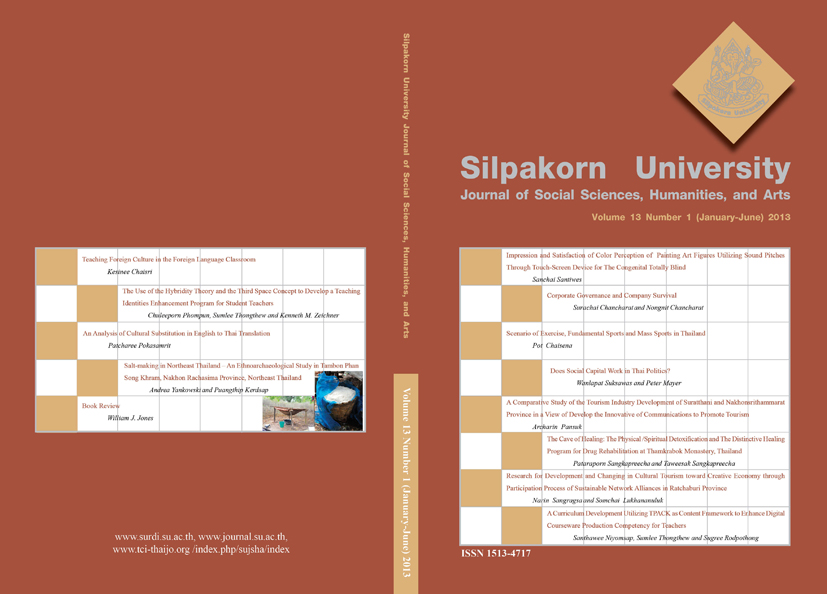Research for Development and Changing in Cultural Tourism toward Creative Economy through Participation Process of Sustainable Network Alliances in Ratchaburi Province
Main Article Content
Abstract
This research was aimed to 1) study the value of art and cultural tourism given along the way of creative economy 2)develop the one management model of cultural tourism 3) compare the successful and failure factors of cultural tourism management in communities 4) study the way of how to manage cultural tourism based on Self-Sufficient Economy Philosophy (3 loops and 2 conditions) through the participation of sustainable network alliances and 5) study the manipulation of significant trips in cultural tourism of Ratchaburi province. Based on the two integrated research methodologies of research and development (R&D) and participatory action research (PAR), this research would be divided into 4 stages as follows: 1st stage: Explored and analyze the basic data. 2nd stage: Design and develop the research instruments based on the basic data mentioned earlier. 3rd stage: Try out the research instruments. 4th stage: Use the instruments to implement, analyze the collected data and conclusion the lesson learnt. The research instruments here were interviewing questionnaire, guideline for in-depth interview and guideline for meeting forum and focus group discussion. The collected data was quantitatively and qualitatively analyzed with Statistical Computer Program Package and technique of content analysis respectively. The results were found and presented as follows: 1) The art and cultural tourism were value by the respondents (tourists and other related groups) at much level (=4.08,=4.16). 2) The one model was developed and so called to “RATCHABURI MODEL” and this abbreviated name was came from 1) R=Research (Research on Tourism) 2) A=Action Learning (Action Learning from Learning Sources) 3) T=Technology (Application of Technology) 4) C= Community of Practice 5) H =Horizontal (Horizontal Relationship of Organization) 6) A= Awareness 7) B=Best Practice (Best Practice accordingto Philosophy of Self-Sufficient Economy) 8) U=Universal (Universal Tourism) 9) R= Responsibility (Community Responsibility) 10) I= Identity (Construction of Outstanding Identity) 3) From the comparative study, the successful factors were the co-working together of three main components namely House, Wat (Temple) and School (HTS) in the tourism management. Furthermore these components also had many of their strengthening points as leaderships, structure of organization, participation of tourist members, technology, knowledge, skills/competencies, management, organizational cultures, public mind and community capitals. When considering into the failure factors they were jealousy, shortage of participation and conflict of interests among communities and tourist members. 4) To manage the cultural tourism it should be proceed on the way of self-sufficient economy and based on background, socio-landscape and interests of community. Also the management should be focused on cost-benefit in many more dimensions than cost recovery in term of economic value. 5) The tourist trips of Ratchaburi province would present to 4 trips as follows 1) Half-Day Trip 2) One Day Trip 3) One Day and One Night Trip 4) Two Days and Two Nights Trip.
Downloads
Article Details
All rights reserved. Apart from citations for the purposes of research, private study, or criticism and review,no part of this publication may be reproduced, stored or transmitted in any other form without prior written permission by the publisher.
References
Creative Industries Task Force. (2001) The Creative Industries Mapping. London : UK Department of Culture, Media and Sport.
Greg, R. (2008) “Creativetourism and Local Development.” In Creative Tourism, a Global Conversation : How to Provide Unique Creative Experience for Travelers Worldwide, edited by R. Wurzburger, T. Aageson, A. Pattakos and S. Pratt. Santa Fe, New Mexico : Sunstone Press.
Mitchop, C. (2010) “Creative economy : New concept in economic driven in the decade.” in Sukhothai Thammathirat University Journal, 5 (1 June): 81-114.
Ministry of Tourism and Sports. (2009) Strategies for Tourism 2009-2013.Bangkok : Policy and Plan Department.
Ralf, B. (1994) International Center for Ecotourism Research. (Research Report, 1993) ICER : Gold Coast.
Sigala, M., and Leslie, D. (Eds.) (2005) International Cultural Tourism: Management, Implications and Cases. USA : Elsevier Science and Technology.
Sungrugsa, N. (2010) The Research Report; A Study of Situation of Cultural Tourism in Nakhon Pathom Province.Nakhon Pathom : Faculty of Education, Silpakorn University.
_________ . (2012 a). Research and Development in Education Book.Nakhon Pathom : Faculty of Education, Silpakorn University.
_________ . (2012 b) Tourism for Education Book. Nakhon Pathom :Faculty of Education, Silpakorn University. Sunkakon, K. (2009) The Research Report; Application for Sufficiency Economic Guideline for Sustainable Community Tourism Development. Changmai : Social Research Institution, Changmai University.


